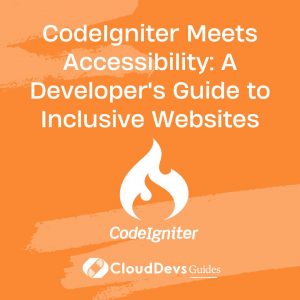CodeIgniter Meets Accessibility: A Developer’s Guide to Inclusive Websites
In the modern digital age, it’s no longer enough for websites to merely be functional or aesthetically pleasing. It’s crucial for them to be accessible to all, regardless of their physical or cognitive abilities. In this post, we’ll explore the concept of web accessibility and delve into how CodeIgniter, a robust PHP framework, can assist developers in building inclusive websites.
1. What is Web Accessibility?
Web accessibility is the practice of ensuring that websites, web applications, and other online resources are usable by everyone, including those with disabilities. This means that all users, irrespective of any disabilities such as vision impairment, hearing loss, motor difficulties, or cognitive impairments, should be able to perceive, understand, navigate, and interact with online content.
2. Why is Web Accessibility Important?
- Legal and Regulatory Compliance: Many countries have regulations that mandate web accessibility. Non-compliance may lead to legal actions and penalties.
- Enhanced User Experience: An accessible website is generally more user-friendly, benefiting not just those with disabilities but all users.
- Wider Audience Reach: Ensuring your site is accessible can expand your audience base to include those with disabilities, which can be substantial in number.
- SEO Benefits: Many accessibility practices also improve SEO, making your site more discoverable.
3. CodeIgniter and Web Accessibility
CodeIgniter, a popular PHP framework, doesn’t inherently make websites accessible. However, its flexibility and vast array of libraries can be leveraged to build accessibility-centric websites. Let’s dive into some specific practices and examples:
3.1. Semantic HTML with CodeIgniter
Using semantic HTML elements can help screen readers decipher content correctly. For example, instead of using a generic `div`, use tags like `article`, `section`, `header`, etc., to provide context.
```php // Instead of this echo '<div>' . $news_item['title'] . '</div>'; // Use this echo '<header>' . $news_item['title'] . '</header>'; ```
3.2. Alt Texts for Images
CodeIgniter provides a handy Image Manipulation library, but it’s essential to ensure every image has an ‘alt’ attribute for screen readers.
```php
// Uploading an image with CodeIgniter
$config['upload_path'] = './uploads/';
$config['allowed_types'] = 'gif|jpg|png';
$this->load->library('upload', $config);
if (!$this->upload->do_upload('userfile')) {
$error = $this->upload->display_errors();
} else {
$data = $this->upload->data();
echo "<img src='".$data['file_name']."' alt='Provide descriptive alt text here'>";
}
```
3.3. Forms and Labels
Ensure every form element has an associated label. This assists both screen readers and users who may struggle with smaller touch targets.
```php
echo form_open('form_controller/method');
echo form_label('Username', 'username');
echo form_input(array('name' => 'username', 'id' => 'username'));
echo form_label('Password', 'password');
echo form_password(array('name' => 'password', 'id' => 'password'));
echo form_submit('submit', 'Login');
echo form_close();
```
4. Responsive Design
A website that isn’t mobile-friendly can be difficult or impossible for some users to navigate. Thankfully, CodeIgniter’s flexibility means it pairs well with frontend frameworks like Bootstrap or Foundation, which have built-in accessibility features.
5. Keyboard Accessibility
All functions of your website should be available using a keyboard. This means:
– Avoiding JavaScript actions that only trigger on mouse events.
– Using tab indexes to control navigation order.
```php
echo form_input(array('name' => 'username', 'id' => 'username', 'tabindex' => '1'));
```
6. ARIA Roles
Accessible Rich Internet Applications (ARIA) roles provide information about an element’s role, state, or property. While HTML5 has brought numerous semantic elements, ARIA can further improve accessibility in situations where semantics are insufficient.
```php
// Declaring a navigation landmark
echo "<nav aria-label='Main navigation'>" . anchor('home/index', 'Home') . "</nav>";
```
Conclusion
Building an accessible website with CodeIgniter is a responsibility and not a choice. While the framework doesn’t directly provide accessibility features, its versatility means developers can and should employ best practices to ensure their web applications are inclusive. As demonstrated, simple steps in your CodeIgniter development process can significantly impact the accessibility of the end product. Let’s make the web usable for everyone!
Table of Contents









